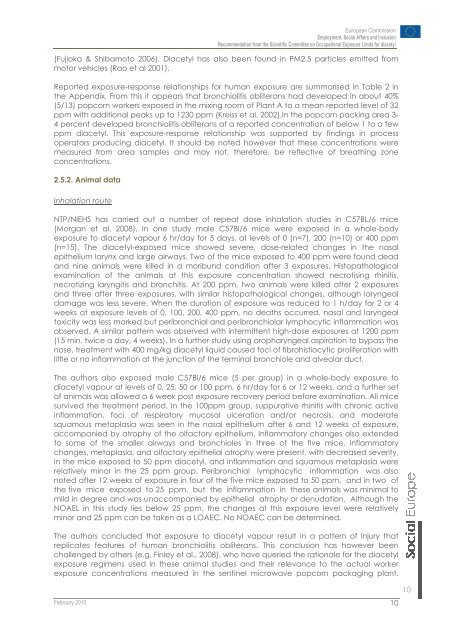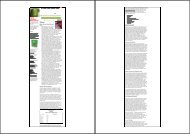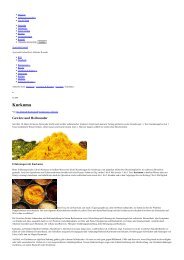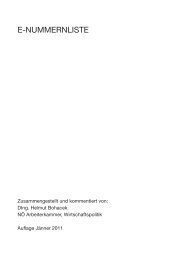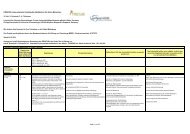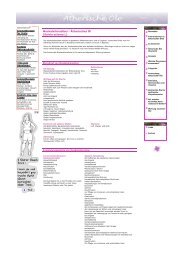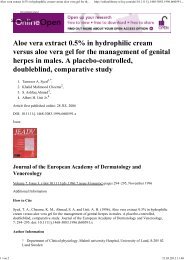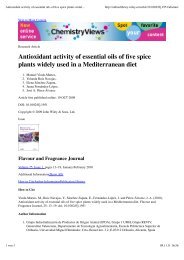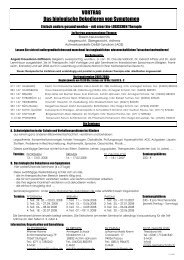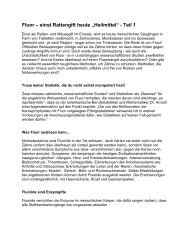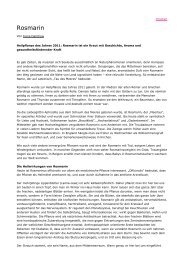Recommendation from the Scientific Committee on Occupational ...
Recommendation from the Scientific Committee on Occupational ...
Recommendation from the Scientific Committee on Occupational ...
You also want an ePaper? Increase the reach of your titles
YUMPU automatically turns print PDFs into web optimized ePapers that Google loves.
February 2010<br />
European Commissi<strong>on</strong><br />
Employment, Social Affairs and Inclusi<strong>on</strong><br />
<str<strong>on</strong>g>Recommendati<strong>on</strong></str<strong>on</strong>g> <str<strong>on</strong>g>from</str<strong>on</strong>g> <str<strong>on</strong>g>the</str<strong>on</strong>g> <str<strong>on</strong>g>Scientific</str<strong>on</strong>g> <str<strong>on</strong>g>Committee</str<strong>on</strong>g> <strong>on</strong> Occupati<strong>on</strong>al Exposure Limits for diacetyl<br />
(Fujioka & Shibamoto 2006). Diacetyl has also been found in PM2.5 particles emitted <str<strong>on</strong>g>from</str<strong>on</strong>g><br />
motor vehicles (Rao et al 2001).<br />
Reported exposure-resp<strong>on</strong>se relati<strong>on</strong>ships for human exposure are summarised in Table 2 in<br />
<str<strong>on</strong>g>the</str<strong>on</strong>g> Appendix. From this it appears that br<strong>on</strong>chiolitis obliterans had developed in about 40%<br />
(5/13) popcorn workers exposed in <str<strong>on</strong>g>the</str<strong>on</strong>g> mixing room of Plant A to a mean reported level of 32<br />
ppm with additi<strong>on</strong>al peaks up to 1230 ppm (Kreiss et al. 2002).In <str<strong>on</strong>g>the</str<strong>on</strong>g> popcorn packing area 3-<br />
4 percent developed br<strong>on</strong>chiolitis obliterans at a reported c<strong>on</strong>centrati<strong>on</strong> of below 1 to a few<br />
ppm diacetyl. This exposure-resp<strong>on</strong>se relati<strong>on</strong>ship was supported by findings in process<br />
operators producing diacetyl. It should be noted however that <str<strong>on</strong>g>the</str<strong>on</strong>g>se c<strong>on</strong>centrati<strong>on</strong>s were<br />
measured <str<strong>on</strong>g>from</str<strong>on</strong>g> area samples and may not, <str<strong>on</strong>g>the</str<strong>on</strong>g>refore, be reflective of breathing z<strong>on</strong>e<br />
c<strong>on</strong>centrati<strong>on</strong>s.<br />
2.5.2. Animal data<br />
Inhalati<strong>on</strong> route<br />
NTP/NIEHS has carried out a number of repeat dose inhalati<strong>on</strong> studies in C57BL/6 mice<br />
(Morgan et al, 2008). In <strong>on</strong>e study male C57Bl/6 mice were exposed in a whole-body<br />
exposure to diacetyl vapour 6 hr/day for 5 days, at levels of 0 (n=7), 200 (n=10) or 400 ppm<br />
(n=15). The diacetyl-exposed mice showed severe, dose-related changes in <str<strong>on</strong>g>the</str<strong>on</strong>g> nasal<br />
epi<str<strong>on</strong>g>the</str<strong>on</strong>g>lium larynx and large airways. Two of <str<strong>on</strong>g>the</str<strong>on</strong>g> mice exposed to 400 ppm were found dead<br />
and nine animals were killed in a moribund c<strong>on</strong>diti<strong>on</strong> after 3 exposures. Histopathological<br />
examinati<strong>on</strong> of <str<strong>on</strong>g>the</str<strong>on</strong>g> animals at this exposure c<strong>on</strong>centrati<strong>on</strong> showed necrotising rhinitis,<br />
necrotizing laryngitis and br<strong>on</strong>chitis. At 200 ppm, two animals were killed after 2 exposures<br />
and three after three exposures, with similar histopathological changes, although laryngeal<br />
damage was less severe. When <str<strong>on</strong>g>the</str<strong>on</strong>g> durati<strong>on</strong> of exposure was reduced to 1 h/day for 2 or 4<br />
weeks at exposure levels of 0, 100, 200, 400 ppm, no deaths occurred, nasal and laryngeal<br />
toxicity was less marked but peribr<strong>on</strong>chial and peribr<strong>on</strong>chiolar lymphocytic inflammati<strong>on</strong> was<br />
observed. A similar pattern was observed with intermittent high-dose exposures at 1200 ppm<br />
(15 min, twice a day, 4 weeks). In a fur<str<strong>on</strong>g>the</str<strong>on</strong>g>r study using oropharyngeal aspirati<strong>on</strong> to bypass <str<strong>on</strong>g>the</str<strong>on</strong>g><br />
nose, treatment with 400 mg/kg diacetyl liquid caused foci of fibrohistiocytic proliferati<strong>on</strong> with<br />
little or no inflammati<strong>on</strong> at <str<strong>on</strong>g>the</str<strong>on</strong>g> juncti<strong>on</strong> of <str<strong>on</strong>g>the</str<strong>on</strong>g> terminal br<strong>on</strong>chiole and alveolar duct.<br />
The authors also exposed male C57Bl/6 mice (5 per group) in a whole-body exposure to<br />
diacetyl vapour at levels of 0, 25, 50 or 100 ppm, 6 hr/day for 6 or 12 weeks, and a fur<str<strong>on</strong>g>the</str<strong>on</strong>g>r set<br />
of animals was allowed a 6 week post exposure recovery period before examinati<strong>on</strong>. All mice<br />
survived <str<strong>on</strong>g>the</str<strong>on</strong>g> treatment period. In <str<strong>on</strong>g>the</str<strong>on</strong>g> 100ppm group, suppurative rhinitis with chr<strong>on</strong>ic active<br />
inflammati<strong>on</strong>, foci of respiratory mucosal ulcerati<strong>on</strong> and/or necrosis, and moderate<br />
squamous metaplasia was seen in <str<strong>on</strong>g>the</str<strong>on</strong>g> nasal epi<str<strong>on</strong>g>the</str<strong>on</strong>g>lium after 6 and 12 weeks of exposure,<br />
accompanied by atrophy of <str<strong>on</strong>g>the</str<strong>on</strong>g> olfactory epi<str<strong>on</strong>g>the</str<strong>on</strong>g>lium. Inflammatory changes also extended<br />
to some of <str<strong>on</strong>g>the</str<strong>on</strong>g> smaller airways and br<strong>on</strong>chioles in three of <str<strong>on</strong>g>the</str<strong>on</strong>g> five mice. Inflammatory<br />
changes, metaplasia, and olfactory epi<str<strong>on</strong>g>the</str<strong>on</strong>g>lial atrophy were present, with decreased severity,<br />
in <str<strong>on</strong>g>the</str<strong>on</strong>g> mice exposed to 50 ppm diacetyl, and inflammati<strong>on</strong> and squamous metaplasia were<br />
relatively minor in <str<strong>on</strong>g>the</str<strong>on</strong>g> 25 ppm group. Peribr<strong>on</strong>chial lymphocytic inflammati<strong>on</strong> was also<br />
noted after 12 weeks of exposure in four of <str<strong>on</strong>g>the</str<strong>on</strong>g> five mice exposed to 50 ppm, and in two of<br />
<str<strong>on</strong>g>the</str<strong>on</strong>g> five mice exposed to 25 ppm, but <str<strong>on</strong>g>the</str<strong>on</strong>g> inflammati<strong>on</strong> in <str<strong>on</strong>g>the</str<strong>on</strong>g>se animals was minimal to<br />
mild in degree and was unaccompanied by epi<str<strong>on</strong>g>the</str<strong>on</strong>g>lial atrophy or denudati<strong>on</strong>. Although <str<strong>on</strong>g>the</str<strong>on</strong>g><br />
NOAEL in this study lies below 25 ppm, <str<strong>on</strong>g>the</str<strong>on</strong>g> changes at this exposure level were relatively<br />
minor and 25 ppm can be taken as a LOAEC. No NOAEC can be determined.<br />
The authors c<strong>on</strong>cluded that exposure to diacetyl vapour result in a pattern of injury that<br />
replicates features of human br<strong>on</strong>chiolitis obliterans. This c<strong>on</strong>clusi<strong>on</strong> has however been<br />
challenged by o<str<strong>on</strong>g>the</str<strong>on</strong>g>rs (e.g. Finley et al., 2008), who have queried <str<strong>on</strong>g>the</str<strong>on</strong>g> rati<strong>on</strong>ale for <str<strong>on</strong>g>the</str<strong>on</strong>g> diacetyl<br />
exposure regimens used in <str<strong>on</strong>g>the</str<strong>on</strong>g>se animal studies and <str<strong>on</strong>g>the</str<strong>on</strong>g>ir relevance to <str<strong>on</strong>g>the</str<strong>on</strong>g> actual worker<br />
exposure c<strong>on</strong>centrati<strong>on</strong>s measured in <str<strong>on</strong>g>the</str<strong>on</strong>g> sentinel microwave popcorn packaging plant.<br />
10<br />
10


